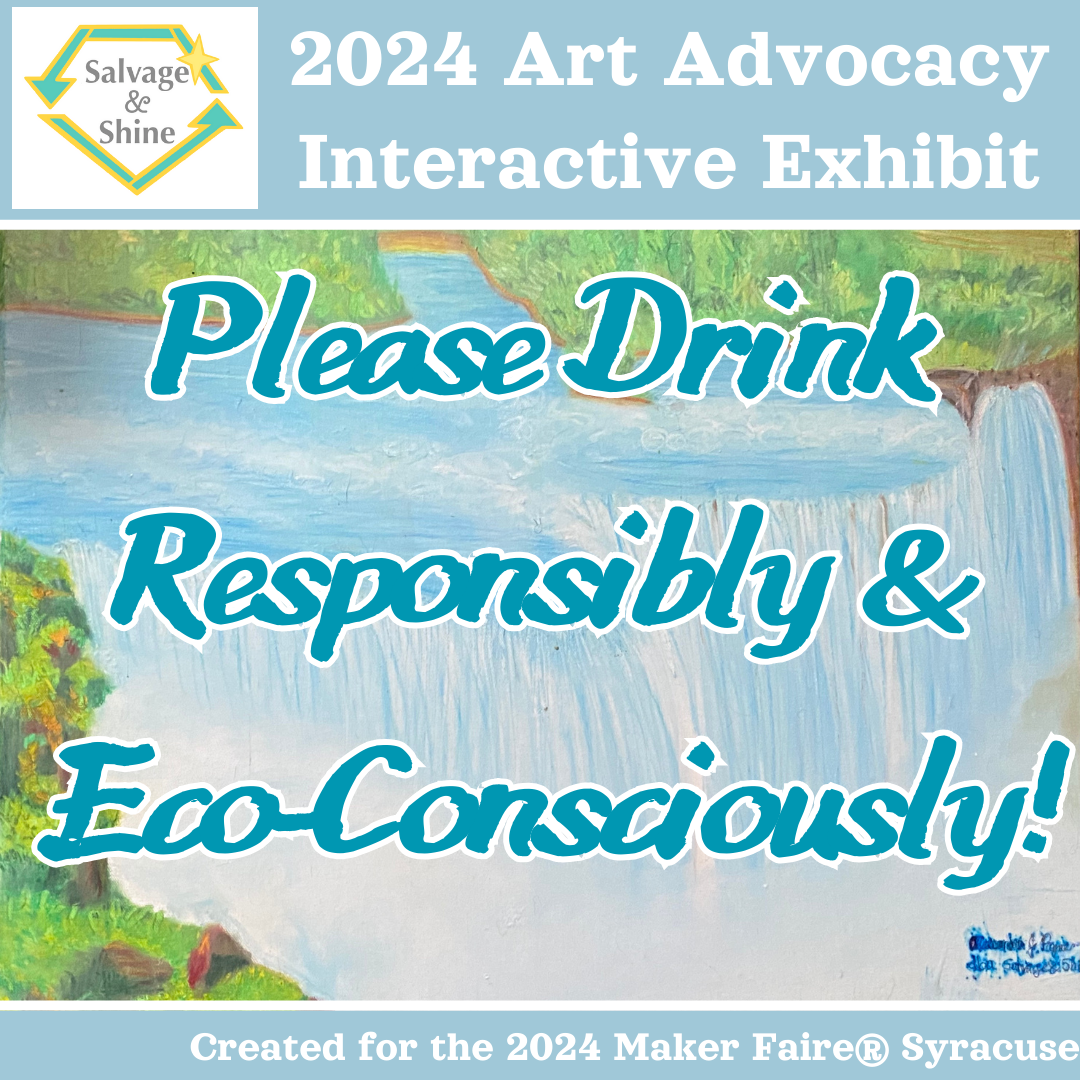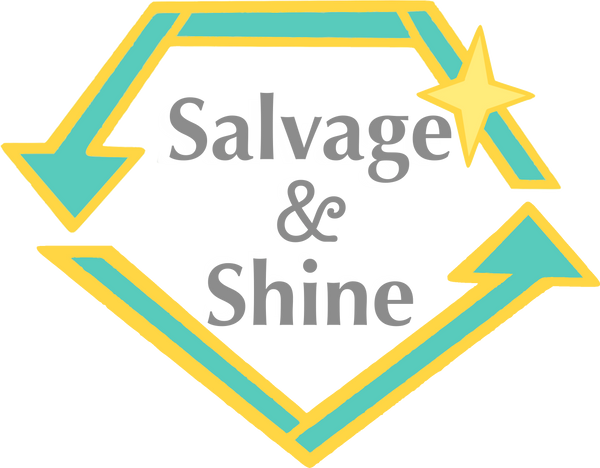
About Salvage & Shine's "Please Drink Responsibly & Eco-Consciously" Art Exhibit
This interactive maker exhibit was created by Alessandra Payne dba Salvage & Shine to simulate addictive cravings while teaching makers how to metal stamp charms to add to drink and sober bracelets. This exhibit was not just about teaching you to stamp charms. This exhibit was created to make you thirsty. I displayed artwork of the Niagara Falls, with pitchers of infused iced water, and played audio of water sounds. The reason why I was trying to make you thirsty is so that you understand how art and visual content can trigger alcoholism and addictive behaviors in people because an addiction is an extreme craving. I want you to understand that alcoholism is not a conscious choice, but an addiction-based illness.
This is where wearable art can also serve as an empowerment tool to communicate personal boundaries and life choices. Creating and using these drinking and sober bracelets will foster more responsible drinking habits at your next social gathering by proactively displaying an individual’s drinking preference; by creating a safe space for people to maintain sobriety; and, by reducing instances of accidentally offering alcohol to a sober person. WE need to shift our thinking that sober people don't know how to relax and party and that alcohol is the best way to liven up a party. The truth is the best parties are ones where all guests feel seen, heard, welcomed, and respected.

The following sections were written to provide recommendations on how to responsibly and eco-consciously plan a party where alcohol is being served, tips on how to consume alcohol responsibly or when to attend a party sober.
How to Drink Alcohol Responsibly
-
Do not drink on an empty stomach. Eat food (the heartier the meal, the better) whenever you are drinking alcoholic beverages. Food slows down the side effects of drinking alcohol.
- Consume alcohol slowly (sip it, do not gulp or chug it). Alcohol is not a drink that quenches your thirst or fills your appetite. Alcohol’s earliest use was medicinal. If you are thirsty, you should have a glass of ice water to drink in between drinking your glass of alcohol.
- Stick to the recommended ages and serving sizes for drinking alcohol. Do not drink alcohol if you are under 21 years old because it is too toxic for your body which is still developing. If you are 21 years or older, you should limit your drink serving sizes to the following: 12 ounces (1.25 cups) of beer that contains 5% alcohol; 5 ounces of wine (0.5 cups) of wine that contains 12% alcohol; or, 1.5 ounces (3 tablespoons) of liquor that contains 40% alcohol.
- Do not binge drink alcohol. You can harm your body if you drink a lot of alcohol in a short time period. Experts define binge drinking alcohol as drinking 4 or more servings within a two-hour time period.
- Do not drink alcohol as a way to unwind or relax. Alcohol is not an anxiety relieving drink nor is it a cure for insomnia, nervousness, anger, sadness, depression, and despair. Alcohol, in small doses, acts as a stimulant; but, in large doses, is a depressant.
- Do not mix alcohol with prescription or recreational drugs. Doing so will reduce the effectiveness of prescription drugs. It can also create harmful side effects that could overload the body and send you to the hospital.
- Do not drink alcohol because someone pressured you to drink it. Drinking alcohol is like eating and drinking anything else! You try a little to taste it and see if you like it. You eat and drink in order to fuel your body with the energy it needs to live. Peer pressure and drinking to fit in or to look cool is not an acceptable reason to drink alcohol.
- Avoid places/parties/events where alcohol is the central focus and where people are not drinking responsibly. Examples include bars that sell alcohol but do not sell food; parties that have alcohol based drinking games and contests; and, events where people are planning to drink until they “get wasted” or “drunk.”
- Pay attention to your body while drinking alcohol for symptoms of drunkenness and alcohol poisoning. Some major symptoms include dizziness, sweating, slower reaction time, loss of muscle control, slurred speech, and inability to walk. For more symptoms, visit the National Institute of Alcohol Abuse and Alcoholism's website.
- Be Sober (abstain and avoid drinking alcohol) if the following applies to you: you do not like the taste; you do not feel like drinking alcohol; you show signs of an allergic reaction; you are unable to digest it easily; you plan to drive home or operate heavy machinery; you have problems sleeping; are pregnant or nursing; you struggle with sticking to the recommended servings of alcoholic beverages; you are taking medications that would become harmful to you if consumed with alcohol; and, you have a personal (and/or family) history of alcohol overdose and addiction.
How to plan an event where guests drink alcohol responsibly and are empowered to stay sober
- Be transparent and explain to guests about your expectations on drinking responsibly. Let your guests know if alcohol will be available at the event, that you expect people to drink it responsibly, and state the consequences of not drinking responsibly. Do not serve alcohol to guests who arrive buzzed or drunk.
- Invite people who are welcoming, nonjudgmental, and respectful of other people’s drinking preferences and sobriety choices. For most people, drinking alcohol is a decision based on their appetites. But for others, it is an addiction that cannot be controlled. Limit invitations to people who do not respect other people’s drinking boundaries or who cannot drink responsibly. These people will make the party an uncomfortable experience for the other guests.
- If you are the host, hire a bartender who is sober and consistently drinks responsibly to ration and serve alcoholic beverages to the guests. The bartender should adhere to the recommended serving sizes by mixing light cocktails and using ice. The bartender should stop serving guests who are showing symptoms of drunkenness. Make non-alcoholic drinks and beverages easily accessible to all guests. Serve non-alcoholic drinks and beverages in closed lid pitchers instead of punch bowls which can be easily “spiked” (someone secretly adding alcohol to a non-alcoholic beverage).
- Require all attendees to wear drink or sober bracelets so that people can easily distinguish between guests who should and should not be served alcohol. Reusable drinking bracelets can help attendees quickly identify sober guests and avoid unintentionally serving them alcoholic beverages. The bracelets should have contrasting colors and properties and all attendees must agree to wear one bracelet (either the drink or the sober bracelet) for the entire time of the party.
- Empower attendees to hold each other accountable. Attendees are not allowed to swap or share bracelets and beverages with other guests. Encourage guests to support and respect one another’s drinking preferences as indicated by the bracelet type. Encourage and reward guests who volunteer as designated drivers to help provide additional support to guests who are too drunk to drive to their next destination.
- Offer guests a hearty meal or appetizer when serving alcohol. Alcohol is less toxic when paired with food. As a host, it is an additional cost, but will cut down on instances of disorderly conduct due to alcohol abuse.
- Consider using drink tickets to limit alcohol consumption and binge drinking. Give each guest drink tickets where the combined number of tickets equal to the daily serving of alochol. The guest will redeem the ticket in order to receive a drink. The bartender stops serving drinks when all tickets have been redeemed.
- Avoid displaying artwork, films, playing games, and playing music where the consumption of alcohol and drugs is the main subject matter. This can trigger cravings in people which can result in irresponsibly drinking behavior and even cause a person to relapse if they struggle with maintaining their sobriety.
- Stop serving alcohol a couple of hours before the event’s end time. Implement a “dry period” (a period where no alcohol is served) a few hours before the end of the event to provide attendees time to sober up and gage whether they need to call a cab/Lyft/Uber or ask for a ride home. During this time, the host should serve warm and cold non-alcoholic beverages (seltzer, water, decaffeinated tea or coffee).
- Call public safety / emergency services if anyone is showing signs of alcohol poisoning. Call 911 on anyone who is showing signs of alcohol abuse or poisoning so that the individual receives timely medical intervention. Any sober attendee that consumes an alcoholic beverage, you should call their counselor, family, and/or sponsor for assistance and support. Take away the car keys from anyone who is not sober enough to walk let alone drive. Do not be afraid! Do it because doing so can save lives!
How to create an Eco-Conscious Event
- Always serve food and drinks in reusable dinnerware. Do not use plastic or melamine products because these products are destroying the planet. Consider using earthenware, bamboo, or heavy-duty paper plates and containers. If using straws use paper or stainless steel. If using serving utensils, use metal, bamboo, or biodegradable fibers. Commit to using products that are biodegradable and made from eco-conscious materials.
- Limit food waste by portioning out the food per guest. Large buffet style food spreads promote overeating. Offer guests food per plate and dish out the meal based on each guest’s preferences. Provide guests space to sit and eat which will allow the guest to consume meals more conscientiously. Guests should reuse plates so that they are aware of their individual food waste.
- Use Eco-Conscious/ Eco-Friendly decorations. Avoid using glitter, balloons, streamers, and other single use decorations. Use music, living plants, and decorations that can be recycled, repurposed, or reused after the event.
- Clean the event using eco-friendly cleaning products. Many people forget to clean before and after the eco-conscious event using environmentally safe cleaning products. This will help keep toxic chemicals out of the air, sewer, and waterways.
- Properly limit and sort your trash waste. Buy bulk containers for larger guest lists to reduce individual packaging waste created by single serve containers. Purchase products from brands that are committed to eco-conscious packaging and to using eco-conscious materials and ingredients. Divert as much trash waste to recycle as possible. Repurpose plastic containers whenever possible, and send the rest to the landfill knowing that you did your best to protect our planet!
About the Sketch Canvas
The 18x24 inch canvas depicts an oil pastel drawing of the Niagara Falls, a famous waterfall in upstate NY using impressionist and surrealist art techniques. The painting was created by Alessandra J. Payne especially for her art advocacy exhibit “Please Drink Responsibly & Eco-Consciously which debuted on May 4, 2024 at the Maker Faire® Syracuse.

###
